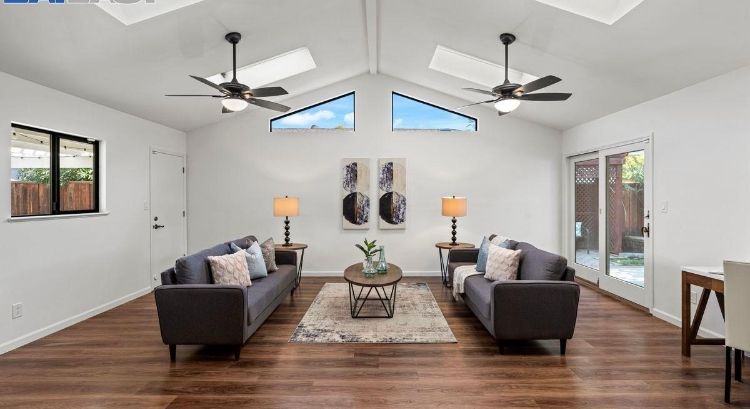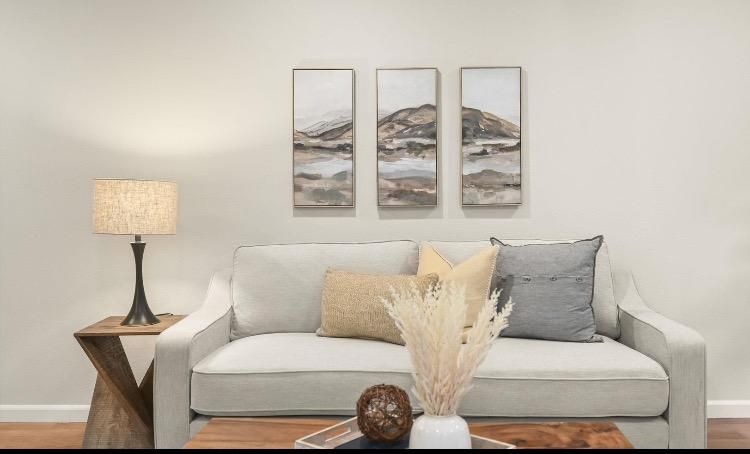The Biggest Home Staging Mistakes
New Title

The Biggest Home Staging Mistakes and How to Avoid Them Maximize Your Home’s Appeal and Avoid These Costly Staging Errors Home staging is one of the most effective ways to sell your home faster and for top dollar—but only if it’s done correctly. In highly competitive markets like Contra Costa, Alameda, and Solano Counties, where buyers have high expectations, even small staging mistakes can cost you time, money, and potential offers. At Elite Staging and Design, we’ve seen it all. Whether you’re selling a luxury home in Alamo, a modern condo in Oakland, or a family home in Fairfield, avoiding these common staging mistakes can make all the difference. 1. Leaving Rooms Empty Mistake: Many sellers assume that an empty home feels larger. Why It’s a Problem: ● Vacant homes lack warmth and personality, making it hard for buyers to envision themselves living there. ● Rooms appear smaller without furniture for scale. ● Online listing photos look uninviting, reducing buyer interest. How to Avoid It: ● Professionally stage key areas like the living room, kitchen, and primary bedroom to create a welcoming feel. ● Use neutral, modern furniture to highlight the home’s layout. Fact: The National Association of Realtors (NAR) found that 81% of buyers find it easier to visualize a property as their future home when it’s staged. 2. Over-Personalizing the Space Mistake: Showcasing bold colors, unique decor, or personal photos. Why It’s a Problem: ● Buyers struggle to see past the seller’s style, making it harder to envision their own. ● Bright colors or eclectic decor can be distracting and make rooms feel smaller. ● Personalized elements alienate buyers, who want a neutral, move-in-ready space. How to Avoid It: ● Stick to neutral tones like soft grays, warm beiges, and crisp whites. ● Swap out bold furniture and artwork for subtle, universally appealing decor. ● Remove family photos, awards, and personal memorabilia to create a clean slate. 3. Ignoring Curb Appeal Mistake: Focusing only on interior staging and neglecting the home’s exterior. Why It’s a Problem: ● First impressions matter. Many buyers drive by a home before scheduling a showing—if the exterior isn’t inviting, they may never step inside. ● Online listings with poor exterior photos get fewer clicks, reducing buyer interest. How to Avoid It: ● Power wash the driveway and walkway for a clean look. ● Add fresh flowers, potted plants, or a new welcome mat. ● Repaint the front door in a neutral or welcoming shade. Fact: Homes with strong curb appeal can sell for up to 7% more than similar homes with neglected exteriors. 4. Using the Wrong Size or Type of Furniture Mistake: Either oversized furniture that makes rooms feel cramped or too little furniture that makes spaces feel empty. Why It’s a Problem: ● Large, bulky furniture shrinks the space visually, making rooms feel smaller than they are. ● Too little or too small furniture makes it hard for buyers to gauge scale and function. How to Avoid It: ● Choose properly scaled furniture that fits the space without overwhelming it. ● Arrange furniture to maximize flow and openness. Example: In smaller homes in Berkeley, opt for a sleek, modern couch instead of a bulky sectional to make the living room feel more spacious. 5. Poor Lighting Choices Mistake: Relying only on overhead lighting or leaving rooms too dark. Why It’s a Problem: ● Dark rooms feel smaller, outdated, and uninviting. ● Overhead lighting alone creates harsh shadows and lacks warmth. ● Buyers perceive poor lighting as a red flag, even if the space itself is great. How to Avoid It: ● Layer lighting with a mix of overhead, table lamps, and accent lights. ● Use soft white or warm LED bulbs for a welcoming ambiance. ● Open curtains and blinds to maximize natural light during showings. 6. Cluttered or Over-Staged Spaces Mistake: Adding too many decorative items, making rooms feel busy or unnatural. Why It’s a Problem: ● Buyers focus on the decor, not the home itself. ● Cluttered spaces feel smaller and overwhelming. ● Over-staging can feel forced and inauthentic, reducing the emotional connection buyers should feel. How to Avoid It: ● Stick to 3 to 5 decor pieces per room—less is more. ● Use a cohesive color palette and limit bold accents. ● Focus on functionality first, then add tasteful decorative touches. 7. Skipping Professional Staging for Key Areas Mistake: Only staging part of the home or attempting DIY staging without expert guidance. Why It’s a Problem: ● Unstaged rooms feel disconnected from the rest of the home. ● Buyers struggle to visualize how spaces flow together. ● DIY staging often lacks the expert touch needed to appeal to today’s buyers. How to Avoid It: ● Prioritize staging the living room, primary bedroom, and kitchen—these are the most important rooms for buyers. ● Work with a professional staging company to create a cohesive, buyer-friendly look. The Bottom Line: Staging the Right Way Helps Your Home Sell Faster and for More Avoiding these common home staging mistakes can increase buyer interest, shorten time on the market, and maximize your sale price. At Elite Staging and Design, we specialize in staging homes across Contra Costa, Alameda, and Solano Counties—ensuring every listing is presented at its absolute best. Thinking About Selling? Let’s Get Your Home Market-Ready! � � Serving Contra Costa, Alameda, and Solano Counties � � Call/Text: [Your Phone Number] � � Email: [Your Email Address] � � Website: [Your Website URL] FAQ: The Biggest Home Staging Mistakes and How to Avoid Them Elite Staging and Design | Serving Contra Costa, Alameda, and Solano Counties This FAQ section is optimized for SEO, voice search, and AI search, ensuring homeowners, real estate agents, and home sellers in Contra Costa, Alameda, and Solano Counties can easily find the right answers when searching for expert home staging advice. 1. What are the most common home staging mistakes sellers make? The biggest home staging mistakes include: ● Leaving rooms empty, making it hard for buyers to visualize the space. ● Using oversized or undersized furniture, which distorts the perception of room size. ● Over-personalizing with bold colors or unique decor, making it difficult for buyers to see themselves in the home. ● Ignoring curb appeal, which can deter buyers before they even step inside. ● Relying on poor lighting, making the home feel dark and uninviting. In Contra Costa County, where buyers expect move-in-ready homes in areas like Danville, Walnut Creek, and Lafayette, avoiding these mistakes is key to securing top-dollar offers. 2. How much does home staging cost in Contra Costa, Alameda, and Solano Counties? The cost of home staging depends on the size and scope of the project, but typical prices in these counties are: ● Condos & smaller homes (under 1,500 sq. ft.): $2,500 – $4,000 ● Mid-sized homes (1,500 – 3,000 sq. ft.): $4,000 – $7,500 ● Luxury homes (3,000+ sq. ft.): $7,500+ In high-demand cities like Pleasanton, Alameda, and Benicia, staging is a small investment compared to the higher sale price it can generate. 3. Is it better to stage a vacant home or leave it empty? Vacant homes should always be staged. An empty home: ● Feels cold, uninviting, and smaller than it actually is. ● Makes it harder for buyers to envision furniture placement. ● Appears less appealing in online listing photos, reducing buyer interest. In cities like Alamo and Orinda, where buyers are searching for high-end properties, staging is especially critical to creating an emotional connection. 4. Can I stage my home myself, or should I hire a professional? DIY staging can work in some cases, but professional staging consistently leads to better results because: ● Experts know buyer preferences in different markets (e.g., modern designs in Berkeley vs. traditional styles in Moraga). ● Professionally staged homes sell faster and for higher prices. ● Buyers make decisions based on emotions, and professional staging creates the right emotional appeal. In Solano County, buyers in Fairfield and Vallejo expect homes to look move-in ready, which is easier to achieve with professional staging. 5. What rooms are the most important to stage? The three most important rooms to stage, according to the National Association of Realtors, are: 1. Living Room (39%) – This is the first space buyers see and the most critical for making a strong first impression. 2. Primary Bedroom (36%) – Buyers want to imagine a relaxing retreat. 3. Kitchen (30%) – The heart of the home, where buyers assess both aesthetics and functionality. In high-end markets like Piedmont and Blackhawk, luxury buyers also focus on dining rooms, outdoor spaces, and home offices. 6. How can I make a small home look bigger when staging? To maximize space in smaller homes in Berkeley, Albany, or Vallejo, follow these staging techniques: ● Use light-colored walls and neutral furniture to create an airy feel. ● Declutter and remove excess furniture to make rooms feel open. ● Use mirrors strategically to reflect light and add depth. ● Arrange furniture to create clear pathways and enhance flow. 7. Does home staging really increase a home's sale price? Yes. Homes that are staged sell for 1-5% more on average than unstaged homes. In high-demand areas like San Ramon and Pleasanton, staging often results in multiple offers and higher final sale prices. Fact: ● A National Association of Realtors (NAR study found that 40% of buyers were more willing to walk through a home they saw online. ● HomeLight reports that staging has a 586% return on investment. 8. How long does home staging take? The home staging process typically takes: ● Consultation & Planning: 1-2 days ● Staging Installation: 1 day for most homes ● Photography & Listing Prep: 1 additional day In fast-moving markets like Martinez and Pleasant Hill, professional staging can be done within 48 hours to meet listing deadlines. 9. Should I stage a home that is already furnished? Yes. Even furnished homes benefit from partial staging, which includes: ● Rearranging existing furniture to improve flow and maximize space. ● Adding modern decor and artwork to create a neutral, stylish appeal. ● Decluttering and depersonalizing to remove distractions for buyers. In luxury areas like Lafayette and Moraga, even high-end homes benefit from fresh staging to highlight the home’s best features. 10. How do I book a home staging consultation in Contra Costa, Alameda, or Solano County? At Elite Staging and Design, we specialize in high-impact, results-driven home staging tailored to local buyers. � � Serving Contra Costa, Alameda, and Solano Counties � � Call/Text: +1.925.967.3131 � � Email: https://www.elite-stage.com/contact � � Website: https://www.elite-stage.com/ Schedule your consultation today and get your home market-ready!


